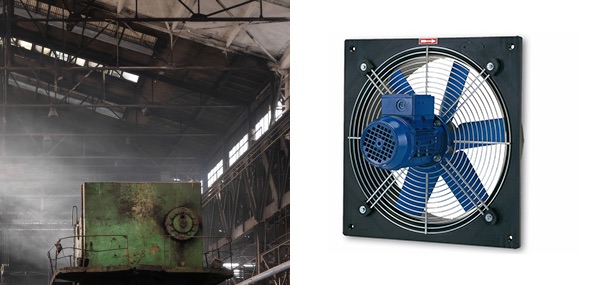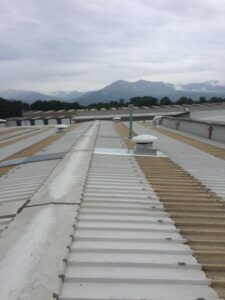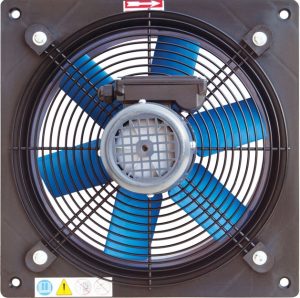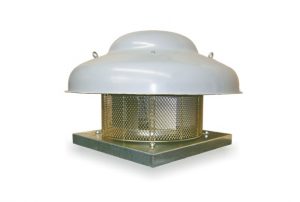
What airflow in cubic meters per hour it takes to properly ventilate my room? Technically the air parts for now correspond to the total volume of the environment that I want to ventilate compared with how many times per hour I want to completely change the air inside.

One of the most important themes for well-being in industrial buildings and premises is air exchange to improve environmental quality and heat disposal during the summer season.
People spend a good part of their lives in enclosed or confined working environments and in these areas, the temperature, humidity and concentration of pollutants in the air are different from those of the outside air, the presence of operating equipment and personnel within the premises.
Some companies during the summer or in the intermediate seasons face the problem of ventilation by opening doors, and windows trying to facilitate ventilation and air exchange inside industrial premises, however this only partially solves the problem because it is not possible at night or in case of rain.
How much air flow in cubic meters/hour does it take to properly ventilate my room? In part we have already faced this theme in a previous article, but we return to the topic more specifically.
Technically the air parts for now correspond to the total volume of the environment that I want to ventilate compared with how many times per hour I want to completely clear the air inside.
| It’s a widely used technique for sizing the ventilation and heat disposal of industrial production environments, warehouses, workshops and factories. It starts from the assumption of changing the air inside by letting it enter again from the outside.
How to proceed for the calculation:
|
 |
Once you have obtained the overall capacity, depending on how the room is structured and how I want to arrange the vacuum cleaners need to divide the total capacity by the number of extractors/ fans you want to install on the roof or wall.
Finally, it is important to evaluate how the reintegration of the extracted air can take place, analyzing the arrangement of the openings present and taking into account that when all the doors and windows are closed the air must be brought back through grids placed in strategic points.
Normally in industrial production environments, it ranges from a minimum of 6/10 spare parts/per hour up to 20 spare parts per hour of foundries, a table is shown with the spare parts now suggested for some typical environments that can be used for sizing.
| Local type | Spare parts/hour | |
| Environments for animals | 20 – 30 | |
| Carpentry – welding | 6 – 10 | |
| Paper mills | 15 – 20 | |
| Laboratories | 6 – 8 | |
| Garages (depots) | 10 – 12 | |
| Garages (repairs) | 12 – 30 | |
| Galvanic baths | 25 – 30 | |
| Paint shops | 20 – 30 | |
| Tanneries | 20 | |
| Workshops | 6 – 20 | |
| Engine rooms | 10 – 15 | |
| Painting booths (locals) | 30 – 60 | |
| Factories in general | 6 – 10 | |
| Celluloid factories | 20 – 30 | |
| Rubber factories | 10 – 20 | |
| Carpentry | 10 – 20 | |
| Foundries | 20 – 30 | |
| Packing rooms | 5 – 10 | |
| Pump rooms | 6 – 12 | |
| Warehouses | 5 – 10 | |
| Kitchens (restaurants) | 20 – 30 | |
| Establishments (dusty) | 10 – 20 | |
| Establishments (in general) | 6 – 10 | |
| Textile mills | 8 – 12 | |
In any case the reference standard for ventilation is UNI10339 within which air conditions and air quality are specified in relation to thermo/hygrometric conditions.
The axial fans or roof Torrini, if properly dimensioned and installed, are very useful to solve mechanically the air exchange and the heat disposal in industrial premises, because they guarantee in every condition a correct ventilation and oxygenation of the working areas. They are also fans that normally do not require complex installations or laying of channels because they must be mounted directly on the ceiling or on the wall. We see the two main types below.
Reduce the internal temperature of the hall and the production area in general, to avoid overheating of the machinery both during the day and during night shifts, where all windows for safety reasons must remain closed.
| Wall-mounted axial fan | Torrino roof fan |
 |
 |
| Wall-mounted axial fans are ideal extractors for applications where high airflow rates are needed and installation with wall or panel mounting. | The Torrino roof fan is to be used ceiling-mounted for direct aspirations on rooms to be ventilated or ducted in pipes up to the roof. |
Fill in the form below to request a quote by email, agree on special conditions, or technical clarifications